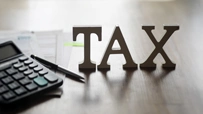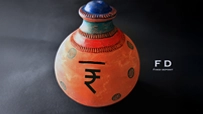How to Open Tax-Saver FD Online
February 18, 2025

If you're looking for a safe and secure way to save on taxes while growing your wealth, opening a Tax-Saver Fixed Deposit (FD) online could be a viable option. With Tax Saver FDs, you can enjoy both - high interest rates and tax deductions of up to ₹1.5 lakh under section 80C of the Income Tax Act, 1961.
In this article, we will guide you through the process of opening an Tax-saver FD online. We'll explain the key features, eligibility criteria, interest payment options, and the necessary steps to open an account.
Understanding Tax-Saver FDs
Tax-saver FDs are special fixed deposit accounts that offer dual benefits – they help you save on taxes and provide an opportunity for wealth growth. These FDs come with a lock-in period of five years, during which you cannot withdraw your deposit.
Here are some key features of Tax-Saver FDs:
Tax Saving on Investment
You can save on your tax outgo with such FDs under Section 80C of the Income Tax Act. However, you can avail this benefit only if you're a part of the old tax regime.
Higher Interest Rates
Tax Saver FDs come with a higher interest rate compared to regular Savings Accounts. However, the lock-in period is 5 years, meaning you cannot withdraw the deposit amount before the stipulated period.
Minimum and Maximum Amount
You can invest a minimum amount of ₹1000 and a maximum amount of ₹1,50,000 in a financial year (FY) towards a Tax-Saver FD. This investment qualifies for tax exemption under section 80C.
Eligibility
Tax-Saver FDs are available for resident individuals and Hindu undivided families (HUFs) only. Non-resident Indians (NRIs) and foreign nationals are not eligible to open this account.
Interest Pay-out Options
Most banks offer three interest payment options for tax-saver FDs – quarterly, monthly, or at maturity. You can choose the option that suits your financial needs.
Now, let's dive into the process of opening an online tax-saver FD with your bank.
How to Open a Tax-Saver FD Online
The account opening process may vary across banks. However, for your ease of understanding, we have taken the process involved in opening a Tax Saver FD online with Ujjivan SFB.
If you are a new customer:
Step 1: Visit Ujjivan SFB website.
Step 2: Go to 'Deposits' and from the dropdown menu select 'Tax Saver FD'
Step 3: Click on 'Apply Now'
Step 4: Fill out the form and click 'Submit'
Bank representatives will contact you to help you with opening the account.
Final Thoughts
Tax Saver FDs can help you with both - save tax and growing your wealth. However, as pointed out before, you can deposit only up to ₹1.5 lakh in such FDs. Also, there's limited liquidity option compared to other Fixed Deposits. However, such FDs can be an excellent instrument to park your money for the long-term and reap the benefits of higher interest rates and the power of compounding. Consider all these factors before investing in Tax-Saver Fixed Deposits.
Disclaimer:
The contents herein are only for informational purposes and generic in nature. The content does not amount to an offer, invitation or solicitation of any kind to buy or sell, and are not intended to create any legal rights or obligations. This information is subject to updation, completion, amendment and verification without notice. The contents herein are also subject to other product-specific terms and conditions, as well as any applicable third-party terms and conditions, for which Ujjivan Small Finance Bank assumes no responsibility or liability.
Nothing contained herein is intended to constitute financial, investment, legal, tax, or any other professional advice or opinion. Please obtain professional advice before making investment or any other decisions. Any investment decisions that may be made by the you shall be at your own sole discretion, independent analysis and evaluation of the risks involved. The use of any information set out in this document is entirely at the user’s own risk. Ujjivan Small Finance Bank Limited makes no representation or warranty, express or implied, as to the accuracy and completeness for any information herein. The Bank disclaims any and all liability for any loss or damage (direct, indirect, consequential, or otherwise) incurred by you due to use of or due to investment, product application decisions made by you on the basis of the contents herein. While the information is prepared in good faith from sources deemed reliable (including public sources), the Bank disclaims any liability with respect to accuracy of information or any error or omission or any loss or damage incurred by anyone in reliance on the contents herein, in any manner whatsoever.
To know more about Ujjivan Small Finance Bank Products Visit:"https://www.ujjivansfb.in"
All intellectual property rights, including copyrights, trademarks, and other proprietary rights, pertaining to the content and materials displayed herein, belong
to Ujjivan Small Finance Bank Limited or its licensors. Unauthorised use or misuse of any intellectual property, or other content displayed herein is strictly prohibited and the same is not intended for distribution to, or use by, any person in any jurisdiction where such distribution or use would (by reason of that person’s nationality, residence or otherwise) be contrary to law or registration or would subject Ujjivan Small Finance Bank Limited or its affiliates to any licensing or registration requirements.
FAQs
1. Is tax-saving option available in the new regime?
No, the tax deduction benefits are not available in the new tax regime.
2. Is the interest earned on Tax Saver FDs taxable?
Yes, the interest income is fully taxable as per Income Tax Act, 1961. Interest earned on FDs is treated as 'Income from Other Sources' as is taxed based on the income tax slab you fall into. However, there's a catch. The TDS (Tax Deducted at Source) is applicable only if your interest income exceeds ₹40,000 in a financial year. For senior citizens, the exemption limit is capped at ₹50.000. Please note that this TDS exemption on FD interest is applicable for FY 2024-25 (till March 2025). For FY 2025-26, the current TDS exemption limit has been hiked to ₹50,000 for regular citizens and ₹1 lakh for senior citizens. Also, if you fall below the minimum tax slab, you can submit Form 15G or Form 15H to the bank requesting not to deduct TDS.
3. What are the options for interest payment frequency?
The interest pay-out option is based on your preference and can be monthly, quarterly or at maturity. Monthly and quarterly interest pay-outs can be beneficial for those seeking a regular income stream.
Latest Blogs

Dussehra 2025: How to Win Your Financial Battles with Smart Saving
Dussehra 2025 (also known as Vijayadashami) falls on Thursday, October 2, 2025.

eSIM Scam in India: I4C Warns Mobile Users About Rising Fraud – How to Stay Safe
The Indian Cybercrime Coordination Centre (I4C), a wing of the Ministry of Home Affairs, issued a strong warning to mobile users about the rapid increase in eSIM fraud in India.

How to Link PAN with Aadhaar: Step-by-Step Guide & Consequences of Not Linking
Linking your Permanent Account Number (PAN) with your Aadhaar is no longer just a best practice.

Annual Information Statement (AIS): A Complete Guide for Stress-Free ITR Filing
India’s tax season is in its final stretch.

ITR-1 (Sahaj) Restrictions: Income Sources Not Allowed & Filing Rules
With just a few days left before the 15 September 2025 deadline for filing Income Tax Returns (ITRs) for Assessment Year (AY) 2025-26, many taxpayers are rushing to submit their forms online.





